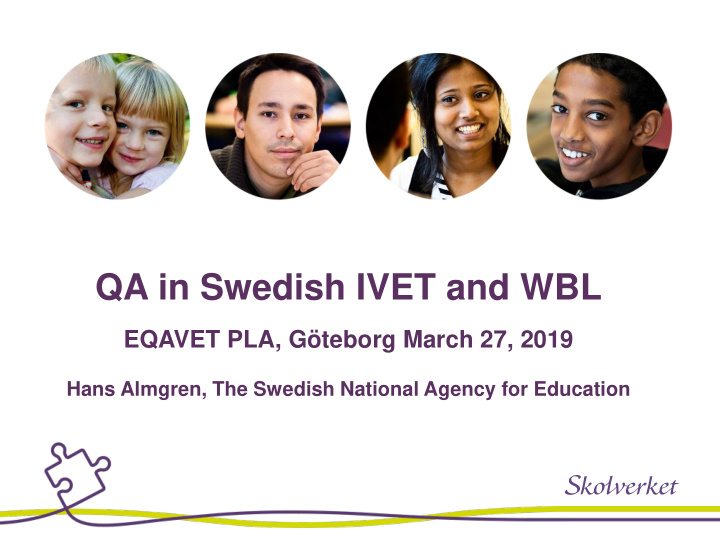



QA in Swedish IVET and WBL EQAVET PLA, Göteborg March 27, 2019 Hans Almgren, The Swedish National Agency for Education
IVET in Sweden Education forms Number of ISCED level SeQF - EQF years level Compulsory school 9 1 and 2 2 Upper secondary 3 3 4 school Municipal adult varying 3 education Higher vocational 1/2 - 3 4 and 5B 5-6 education 2 – 6 University and 5A and 6 6-8 university colleges
Goal steered system with a high degree of local responsibility. • Legislative function: Centralised • Provision: Decentralised. Municipalities and the organisers of The Swedish Riksdag (Parliament) independent schools. and the government draw up the overall national goals. • Control function: Schools Inspectorate (state agency) • Supportive function: The National monitors. Agency for Education operationalizes the legislation.
Upper secondary education • All students who have completed compulsory schooling are offered upper secondary education by their home municipality. • This right applies to students up to the age of 20. • IVET is available in Adult Education for students over the age of 20. • Free of charge and voluntary. • 18 programmes, out of which 12 are IVET-programmes.
Vocational programmes/ Higher education preparatory Apprenticeship education programmes • Child and Recreation • Business Management and Economics • Building and Construction • Arts • Electricity and Energy • Humanities • Vehicle and Transport • Natural Science • Business and Administration • Social Science • Handicraft • Technology • Hotel and Tourism • Industrial technology • Natural Resource Use • Restaurant Management and Food • HVAC and Property Management • Health and Social Care
Programme stucture Higher education Vocational programmes preparatory programmes Admission requirements: Admission requirements: Passing grades in 8 Passing grades in 12 subjects. subjects. 2500 points 2500 points 2500 points School based VET Apprentice based VET • • • 3 years 3 years 3 years • • • 2180 hours 2430 hours 2430 hours • • Minimum 15 weeks of Minimum 50% work- work-based learning based learning (1215 (345 hours) hours) • • Provide eligibility to Provide basic eligibility to tertiary education if tertiary education. students choose some elective courses.
Foundation subjects Common for all upper secondary programmes: • Swedish or Swedish as second language • English • Mathematics • Natural Sciences • Social Sciences (Civics, Religion and History) • Physical education and health
Programme stucture Vocational Higher Education programme: preparatory programme: Industrial Technology technology Foundation subjects 600 points 1100 points Programme specific 400 points 400 points subjects Orientation 300-400 points 300 points Programme 800-900 points 400 points specialisations Individual options 200 points 200 points Diploma project 100 points 100 points
Programme stucture Vocational Higher Education programme: preparatory programme: Industrial Technology technology Foundation subjects 600 points 1100 points Programme specific 400 points 400 points subjects Orientation 300-400 points 300 points Programme 800-900 points 400 points specialisations Individual options 200 points 200 points Diploma project 100 points 100 points
Programme stucture Vocational Higher Education programme: preparatory programme: Industrial Technology technology Foundation subjects 600 points 1100 points Programme specific 400 points 400 points subjects Orientation 300-400 points 300 points Programme 800-900 points 400 points specialisations Individual options 200 points 200 points Diploma project 100 points 100 points Fourth vocational year 800 points EQF 5
Work-based learning
Work-based learning • Develop an understanding the vocational culture, becoming part of the vocational community, developing a vocational identity. • WBL is steered by the subject syllabuses = assessed, credit driven. • The school/teacher is responsible for assessing the learning. • The school is responsible for provision of WBL. • 12% of IVET learners are apprentices.
Role of the companies • The company has to provide a trainer for the work placement. • There are financial incentives for companies to take on students for WBL • Upper secondary apprentices can be employed and remunerated.
Quality Assurance
Swedish model EQAVET model
Quality assurance • National state Systematic quality assurance is mandatory. • (Education Act) Control function (Inspectorate). • Education Required to plan, evaluate and develop the education Organiser it organises. • Required to document the process. • Reciever of complaints from individuals. • School Required to plan, evaluate and develop the education. • (Head master) Teachers, students have to be involved. • WBL is part of the curriculum and should be included in the QA process.
Self assessment • QA at provider level is mainly performed through self assessment. • The National Agency for Education (and other organisations) provide tools and support. e.g. - NAE: https://www.skolverket.se/skolutveckling/nationella- skolutvecklingsprogram#h-ProgramSystematisktkvalitetsarbete - SALAR/LIKA: https://lika.skl.se/
Quantitative data Qualitative data (Statistics: e.g. average (e.g. relevance of WBL; grades, completion rates, utilisation of acquired graduate tracking, skills) vulnerable groups) Provider level Available, evalutated, inspected. Known to the provider? Available, evalutated. Anecdotal data. System level Schools Inspectorate: thematic quality reports.
Challenges We do a lot of things right, … • A lot of quantitative data at all levels.
Challenges We do a lot of things right, … … but do we do the right things? • A lot of quantitative data at all • Little knowledge of how e.g. WBL levels. is assessed. • Little aggregerated knowledge of qualitative data at national level.
Recommend
More recommend